
Tabebuia is a genus of flowering plants in the family Bignoniaceae. Tabebuia consists almost entirely of trees, but a few are often large shrubs. A few species produce timber, but the genus is mostly known for those that are cultivated as flowering trees.

Bignoniaceae is a family of flowering plants in the order Lamiales commonly known as the bignonias or trumpet vines. It is not known to which of the other families in the order it is most closely related.
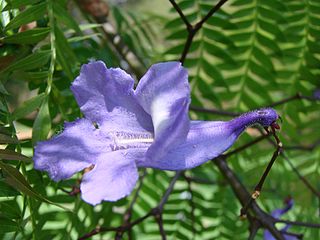
Jacaranda is a genus of 49 species of flowering plants in the family Bignoniaceae, native to tropical and subtropical regions of the Americas while cultivated around the world. The generic name is also used as the common name.

Paulowniaceae are a family of flowering plants within the Lamiales. They are a monophyletic and monogeneric family of trees with currently 7 confirmed species. They were formerly placed within Scrophulariaceae sensu lato, or as a segregate of the Bignoniaceae.

Tecoma is a genus of seven species of shrubs or small trees in the trumpet vine family, Bignoniaceae. They are native to the Americas, ranging from the extreme southern United States through Central America and the Antilles south through Andean South America to northern Argentina. The generic name is derived from the Nahuatl word tecomaxochitl, which was applied by the indigenous peoples of Mexico to plants with tubular flowers. Trumpetbush is a common name for plants in this genus.
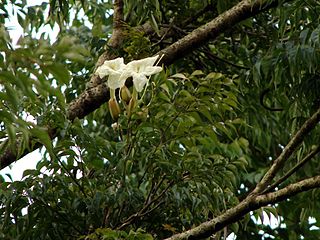
Radermachera sinica, also called china doll, serpent tree or emerald tree, is an evergreen tree in the family Bignoniaceae, native to the subtropical mountain regions of southern China and Taiwan.

Erica vagans, the Cornish heath or wandering heath, is a species of flowering plant in the family Ericaceae, native to Ireland, Cornwall, western France and Spain. It is a vigorous, spreading, evergreen heather reaching 75 cm (30 in) tall and wide, with pink flowers borne in racemes 14 cm (6 in) long in summer and autumn. The Latin specific epithet vagans literally means "wandering"; in this context it means "widely distributed".
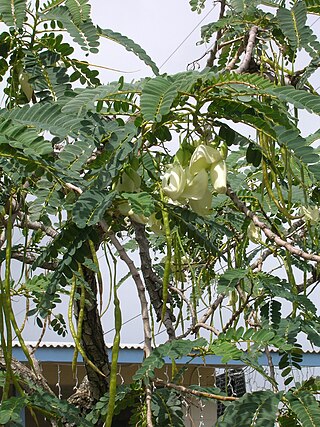
Sesbania grandiflora, commonly known as vegetable hummingbird, katurai, agati, or West Indian pea, is a small leguminous tree native to Maritime Southeast Asia and Northern Australia. It has edible flowers and leaves commonly eaten in Southeast Asia and South Asia.

Dolichandrone spathacea, also known as tui or mangrove trumpet tree, is a species of plant in the family Bignoniaceae. It is found from South India, Sri Lanka to New Caledonia.
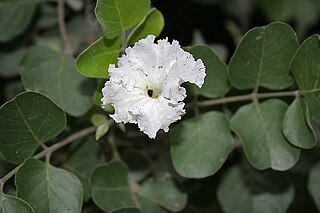
Dolichandrone falcata is a small deciduous tree in the family Bignoniaceae. It is endemic to India. Tree attains a height of 15–20 feet. Leaves are compound 2-6 inches long with 3-6 obovate or oval shaped leaflets. Flowers are white and fragrant. Flowering occurs in April–May.

Tecomeae is a tribe with 44 genera of trees, shrubs, and vines in the family Bignoniaceae.
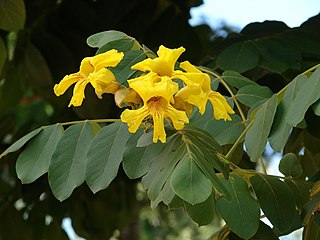
Markhamia lutea, the Nile tulip, Nile trumpet or siala tree is a tree species of the family Bignoniaceae, native to eastern Africa and cultivated for its large bright yellow flowers. It is related to the African tulip tree. Native to Africa, Markhamia was named in the honour of Clements Markham (1830-1916), who worked in India. An evergreen small tree that grows to 4–5 m in height outside of native zones, although it can reach more than 10 m in its zones of origin. Leaves, of 20–30 cm in length, normally arranged in groups in the ends of the branches. Flowers in terminal clusters. They are trumpet shaped, yellow in colour, with orange-reddish spots in the throat. They measure 5–6 cm in length. Fruit is a capsule, of up to 70 cm in length, with abundant winged seeds. It is propagated by seeds.
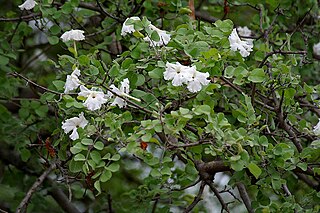
Dolichandrone is a genus of flowering plants in the family Bignoniaceae.

Markhamia is a genus of flowering plants in the family Bignoniaceae. The genus is named after Clements Markham.
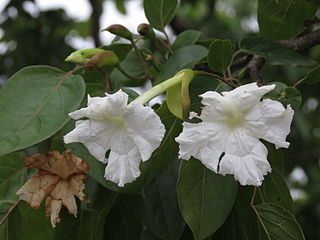
Dolichandrone atrovirens, also known as wavy trumpet flower, is a deciduous tree in the family Bignoniaceae. It is endemic to the Indian subcontinent.

Markhamia stipulata is a species of plant in the family Bignoniaceae. It is native to South China and Southeast Asia. This species usually grows as a tall tree, reaching heights of 5–15 m. Stipulata thrives in sparsely treed areas, such as fields. Flowers are pale yellow to reddish brown.

Markhamia obtusifolia is a species of plant in the family Bignoniaceae. It is found in Southern Africa.
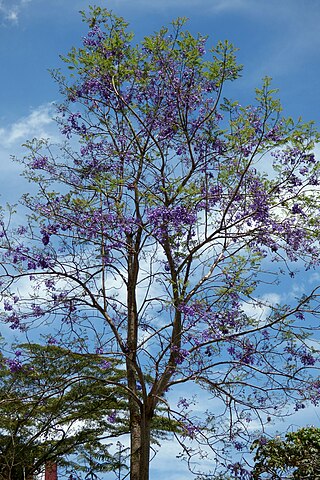
Jacaranda caucana is a species of flowering tree first described by Swiss-born botanist Henri François Pittier in 1917. It is native to Costa Rica, Panama, the Dominican Republic, Venezuela and Colombia.
Dolichandrone arcuata, known in Malayalam as pambukaimaram, is a deciduous tree in the Bignoniaceae family. This species is native to the dry, deciduous forests of the Eastern Ghats in the Indian subcontinent. It is a medium-sized tree, reaching up to 16 m (52 ft) in height.

Heterophragma is a genus of two species of tree, constituting part of the plant family Bignoniaceae. The species are found in Southeast Asia and India.






















